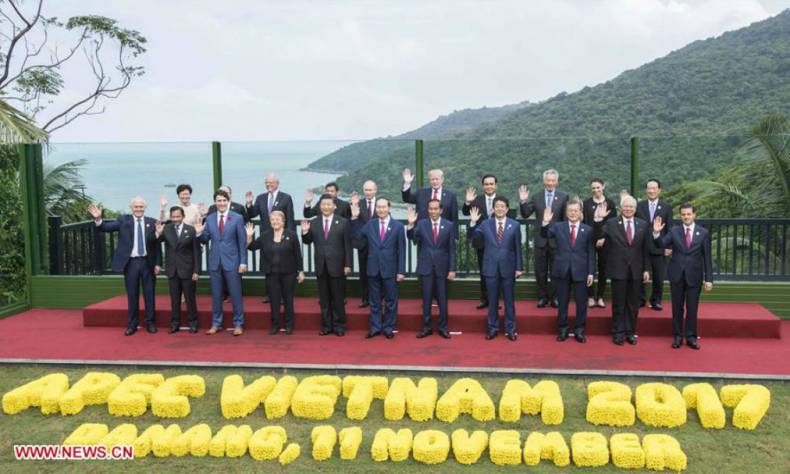
Commentary: APEC Members to Draw Post-2020 Vision Together
APEC members are now eager to prepare for a post-2020 blueprint by finding out new directions and drawing out new roadmap as the year of 2020 is now around the corner.
In 1994, members of Asia-Pacific Economic Cooperation (APEC) set a goal of liberalizing trade and investment among the developed economies by 2010 and developing economies by 2020, better known as the Bogor Goals.
Bogor Goals, a cornerstone of the APEC agenda, were written in the Bogor Declaration issued during the 2nd APEC Economic Leaders’ Meeting in the Indonesian city of Bogor.
Over the past 20-plus years, the APEC members, though varied in development levels, have accomplished a lot in lowering tariffs, eliminating trade barriers, liberalizing trade and facilitating investments by taking the Bogor Goals as a guideline.
Data shows that trade in goods in the Asia-Pacific region has witnessed a quadruple growth, while the absorbing foreign capital and outbound investment in the region soared by 600 percent. Thanks to closer economic and trade ties among the APEC members, people there are living a much more decent life.
The members are now eager to prepare for a post-2020 blueprint by finding out new directions and drawing out new roadmap as the year of 2020 is now around the corner.
The 22nd APEC Economic Leaders’ Meeting hosted by China three years ago provided enlightenment for the long-term development of APEC mechanism.
Chinese President Xi Jinping, at the 2014 meeting, stressed that it meets the common interests of all members to foster an open economy in the Asia-Pacific featuring innovative development, interconnected growth and converging interests.
To realize the goal, he urged the big APEC family to work together to build an Asia-Pacific partnership of mutual trust, inclusiveness, cooperation and win-win progress, saying that this will inject new energy into the economic development of both the Asia-Pacific and the world. The Beijing meeting fell in the 25th anniversary of APEC and 20th birthday of Bogor Goals.
A series of important documents were adopted at the Beijing summit thanks to China’s efforts, including “Statement on the 25th Anniversary of APEC – Shaping the Future through Asia-Pacific Partnership,” “Beijing Roadmap for APEC’s Contribution to the Realization of the FTAAP,” “APEC Connectivity Blueprint for 2015-2025” as well as “APEC Accord on Innovative Development, Economic Reform and Growth.”
Xi urged the members to fulfill “Asia-Pacific dream” by redoubling efforts to forge a partnership of mutual trust, inclusiveness and win-win cooperation. The blueprint envisaged by him is of great value for APEC cooperation.
In addition, the Free Trade Area of the Asia-Pacific (FTAAP), connectivity, structural reforms and innovation-driven development were selected by the members as symbolic cooperation agendas during the meeting, laying a foundation for the medium- and long-term framework of APEC cooperation.
A great deal of follow-up efforts has been done to implement the decisions of the Beijing meeting. The members, in their 2016 gathering in Peru, concluded their collective strategic study on FTAAP, adopt the Lima Declaration on FTAAP, and agreed to formulate a working plan.
The APEC economies also pooled their consensus by holding policy dialogues, exchanging information and reinforcing the capability-building of the zone.
As a result of all the endeavors, the members have embraced booming practical cooperation on connectivity and accelerated link-up of supply chain in the region. The Model E-Port Network, a working group on e-commerce, port services network and some other mechanisms advocated by China have played their role as well.
Reform and innovation were given more weight by APEC members. This year, they finalized the Cross-border E-commerce Facilitation Framework, worked out the roadmap for Internet and digital economy, and stepped up efforts on practical cooperation, experience sharing and capability-building.
Vietnam, host of this year’s meeting, has selected post-2020 vision as a key agenda. In order to ensure that APEC members could reach consensus on new vision before 2020, exchanges will be organized and working group is expected to be set up to draft a report.
China also drew a blueprint for its future development at the 19th National Congress of the Communist Party of China (CPC) concluded last month.
The “Asia-Pacific dream” can also find an echo from the Chinese Dream. The Asia-Pacific region will enjoy new impetus brought by China’s efforts to secure a decisive victory in building a moderately prosperous society in all respects and embark on a journey to fully build a modern socialist China.
Starting from the reality, China will, guided by the Asia-Pacific partnership, explore the post-2020 vision together with other APEC members by bearing a far-sighted horizon, taking all factors into consideration and pooling consensus.
The author is the China’s senior official for APEC
 Facebook
Facebook
 Twitter
Twitter
 Linkedin
Linkedin
 Google +
Google +










